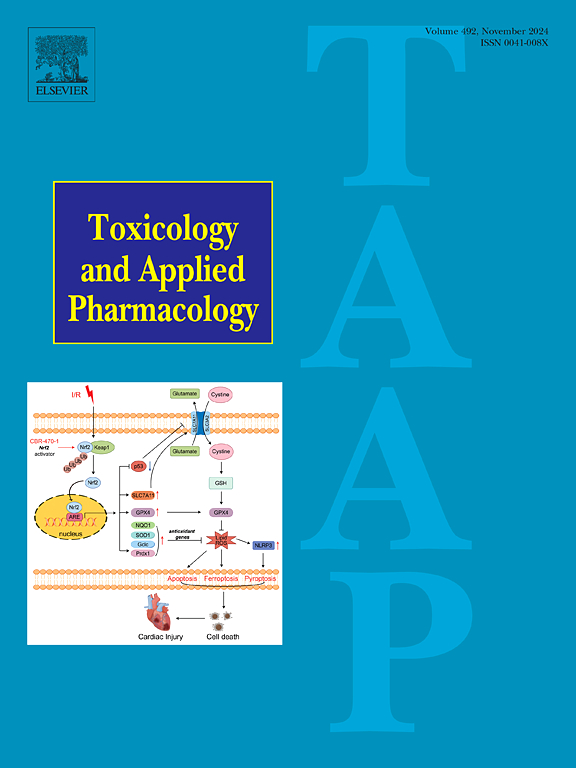Alisertib通过抑制STAT3激活抑制急性髓系白血病细胞生长
IF 3.3
3区 医学
Q2 PHARMACOLOGY & PHARMACY
引用次数: 0
摘要
极光激酶A (AURKA)在细胞周期中起着至关重要的作用。它的致癌功能已经在各种类型的癌症中得到证实。然而,其在急性髓性白血病(AML)中的作用尚未被广泛探讨。Alisertib是一种选择性AURKA抑制剂,目前正在临床试验中评估治疗几种癌症的效果。在这项研究中,我们旨在评估alisertib的疗效并阐明其在AML细胞中的分子机制。体外和体内实验分别采用western blotting和免疫细胞化学方法,鉴定alisertib对两种AML细胞系(KG-1和MOLM-13)的影响。来自三名AML患者的原代细胞被用来检测对alisertib治疗的反应。结果显示,alisertib在KG-1和MOLM-13细胞系中均能显著降低AURKA Thr288磷酸化。有趣的是,它选择性地抑制STAT3在Tyr705位点的磷酸化,而不是在Ser727位点。值得注意的是,alisertib在短期治疗后显著降低了白介素-6诱导的核pTyr705-STAT3水平,同时也影响了下游c-Myc的表达。除了这些体外研究结果外,使用KG-1细胞的体内异种移植物模型在alisertib治疗后显示出明显的肿瘤生长迟缓,并伴有pTyr705-STAT3抑制。在原发性AML患者细胞中,我们观察到alisertib诱导的pTyr705-STAT3的降低和细胞生长抑制的一致趋势。总之,AURKA和alisertib是AML有希望的治疗靶点和治疗选择。本文章由计算机程序翻译,如有差异,请以英文原文为准。

Alisertib inhibits acute myeloid leukemia cell growth by inhibiting STAT3 activation
Aurora kinase A (AURKA) plays critical roles in the cell cycle. Its oncogenic functions have been identified in various types of cancer. However, its role in acute myeloid leukemia (AML) has not been extensively explored. Alisertib, a selective AURKA inhibitor, is currently being evaluated in clinical trials for the treatment of several cancers. In this study, we aimed to assess the efficacy of alisertib and elucidate its molecular mechanisms in AML cells. In vitro and in vivo experiments were conducted using western blotting and immunocytochemistry, respectively, to identify the effects of alisertib on two AML cell lines (KG-1 and MOLM-13). Primary cells from three patients with AML were used to examine the response to alisertib treatment. The results showed alisertib significantly reduced Thr288 phosphorylation of AURKA in both KG-1 and MOLM-13 cell lines. Interestingly, it selectively inhibited STAT3 phosphorylation at Tyr705, but not at Ser727. Notably, alisertib significantly decreased interleukin-6-induced nuclear pTyr705-STAT3 levels after short-term treatment, while also affecting the expression of downstream c-Myc. In addition to these in vitro findings, in vivo xenograft model using KG-1 cells showed significant tumor growth retardation accompanied by pTyr705-STAT3 inhibition following alisertib treatment. In primary AML patient cells, we observed a consistent trend in the alisertib-induced reduction of pTyr705-STAT3 and cell growth inhibition. In conclusion, AURKA and alisertib are promising therapeutic targets and treatment options for AML.
求助全文
通过发布文献求助,成功后即可免费获取论文全文。
去求助
来源期刊
CiteScore
6.80
自引率
2.60%
发文量
309
审稿时长
32 days
期刊介绍:
Toxicology and Applied Pharmacology publishes original scientific research of relevance to animals or humans pertaining to the action of chemicals, drugs, or chemically-defined natural products.
Regular articles address mechanistic approaches to physiological, pharmacologic, biochemical, cellular, or molecular understanding of toxicologic/pathologic lesions and to methods used to describe these responses. Safety Science articles address outstanding state-of-the-art preclinical and human translational characterization of drug and chemical safety employing cutting-edge science. Highly significant Regulatory Safety Science articles will also be considered in this category. Papers concerned with alternatives to the use of experimental animals are encouraged.
Short articles report on high impact studies of broad interest to readers of TAAP that would benefit from rapid publication. These articles should contain no more than a combined total of four figures and tables. Authors should include in their cover letter the justification for consideration of their manuscript as a short article.

 求助内容:
求助内容: 应助结果提醒方式:
应助结果提醒方式:


